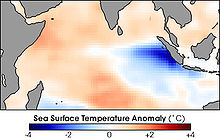印度洋偶极

印度洋偶极(Indian Ocean Dipole)或印度洋双极是指印度洋异常的气候振荡现象,由气候研究人员于1999年发现,现象出现时会使印度洋东西侧的海水温度混乱,改变正常风向。整个气候模式的变化,造成一些地区干旱而另一些地区又降雨量过多,情况类似厄尔尼诺现象。此现象分别有正负两个极端,当印度洋西侧海面温度比正常高时称为正偶极,相反则称为负偶极。[1][2]
当正偶极发生时,印度洋西侧海面温度异常地持续变暖,该区大气对流变得活跃,非洲东部因而会产生较大降雨,而在印度洋东侧却相反,海面温度下降,东南亚和澳大利亚等地会出现干旱,加大火灾风险。
当负偶极发生时,印度洋西侧海面温度异常地持续低温,该区大气对流变得缓慢,非洲东部因而会只有较少降雨,而在印度洋东侧却相反,海面温度变暖,东南亚和澳大利亚等地会产生大雨,加大水灾风险。
发生[编辑]
过去,每30年平均发生4次正偶极或阴偶极,每次持续约6个月。连续多年发生正偶极的情况十分罕见,记录上只有两次,即1913年至1914年,以及2006年至2008年。[3][4][5][6]
2006年及2008年连续三年出现了正偶极,及后发生了严重的2009年维多利亚森林大火。
2010年10月出现了一次强烈的负偶极,[7]加上同年发生的反厄尔尼诺现象,造成了严重的2010-2011年昆士兰洪水与2011维多利亚州洪水。
2019年出现了一次强烈的正偶极,[8],[9]加上厄尔尼诺现象,同年发生了严重的2019-2020年澳洲丛林大火。
相关[编辑]
参考资料[编辑]
- ^ Saji et al. 1999
- ^ Webster, P.J.; Moore, A.M:Loschnigg, J.P., Leben, R.P. Coupled ocean–atmosphere dynamics in the Indian Ocean during 1997–98. Letters to Nature. 1999, 401 (6751): 356–360. Bibcode:1999Natur.401..356W. PMID 16862107. doi:10.1038/43848.
- ^ Cai W, Pan A, Roemmich D, Cowan T, Guo X. Argo profiles a rare occurrence of three consecutive positive Indian Ocean Dipole events, 2006–2008. Geophysical Research Letters. 2009, 36 (8): L037038 [2020-01-08]. Bibcode:2009GeoRL..36.8701C. doi:10.1029/2008GL037038. (原始内容存档于2012-09-23).
- ^ Cooper, Dani. Bushfire origins lie in Indian Ocean. Australian Broadcasting Corporation. March 25, 2009 [December 22, 2009]. (原始内容存档于2019-05-22).
- ^ Perry, Michael. Indian Ocean linked to Australian droughts. Reuters. February 5, 2009 [December 22, 2009]. (原始内容存档于2022-04-07).
- ^ Rosebro, Jack. Australi Reels From Split Weather System. Green Car Congress. February 12, 2009 [December 22, 2009]. (原始内容存档于2020-08-09).
- ^ Seasonal Prediction: ENSO forecast, Indian Ocean forecast, Regional forecast. Low-latitude Climate Prediction Research. JAMSTEC. [2020-01-08]. (原始内容存档于2013-01-22).
- ^ Tan, Audrey. Dry spell likely caused by climate phenomenon. The New Paper. 2019-08-22 [2019-09-12]. (原始内容存档于2020-03-14) (英语).
- ^ Tan, Audrey. Dry spell in Singapore likely to last several months. The Straits Times. 2019-08-22 [2019-09-12]. (原始内容存档于2020-03-06) (英语).
延伸阅读[编辑]
- Abram, Nerilie J.; et al. Seasonal characteristics of the Indian Ocean dipole during the Holocene epoch. Nature. 2007, 445 (7125): 299–302. Bibcode:2007Natur.445..299A. PMID 17230187. doi:10.1038/nature05477.
- Ashok, Karumuri; Guan, Zhaoyong; Yamagata, Toshio. Impact of the Indian Ocean Dipole on the Relationship between the Indian Monsoon Rainfall and ENSO. Geophysical Research Letters. 2001, 28 (23): 4499–4502. Bibcode:2001GeoRL..28.4499A. doi:10.1029/2001GL013294.
- Li, Tim; et al. A Theory for the Indian Ocean Dipole–Zonal Mode. Journal of the Atmospheric Sciences. 2003, 60 (17): 2119–35. Bibcode:2003JAtS...60.2119L. doi:10.1175/1520-0469(2003)060<2119:ATFTIO>2.0.CO;2.
- Rao, S. A.; et al. Interannual variability in the subsurface Indian Ocean with special emphasis on the Indian Ocean Dipole. Deep-Sea Research Part II. 2002, 49 (7–8): 1549–72. Bibcode:2002DSR....49.1549R. doi:10.1016/S0967-0645(01)00158-8.
- Saji, N. H.; et al. A dipole mode in the tropical Indian Ocean. Nature. 1999, 401 (6751): 360–3. PMID 16862108. doi:10.1038/43854.
- Behera, S. K.; et al. Unusual IOD event of 2007. Geophysical Research Letters. 2008, 35 (14): L14S11. Bibcode:2008GeoRL..3514S11B. doi:10.1029/2008GL034122.
外部链接[编辑]
| 维基共享资源上的相关多媒体资源:印度洋偶极 |
| |||||||||||||||||||||||||||
| |||||||||||||||||||||||||||||||||||||||||||||||||||||||||||||||||||||||||||||||||||||||||||||||||||||||||||||||||||||||||||||||||||||||||||||||||||||||


